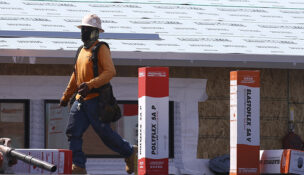‘Let’s go herping’
Arizona Capitol Reports Staff//August 18, 2006//[read_meter]

Not a box turtle
This desert tortoise, used for education and research, can’t quite make it out of his box.
When nobody was looking, the Gila monster made a break for it. It crawled unnoticed into the desert scrub at Phoenix South Mountain Park.
A biologist for the Arizona Game and Fish Department had set the beady lizard loose to help promote the agency’s newest publication, “A Field Guide to Amphibians and Reptiles in Arizona.” After everybody had a look, it was meant to go to back in the bag.
But all eyes soon turned to the speckled rattlesnake. It appeared irritable and cranky the moment researcher Thomas Brennan set it on the desert floor with a handler’s pole.
Meanwhile, the desert tortoise was out its box and slowly on the lam, headed for the nearest wash.
All three animals, now captive display creatures, probably felt right at home in the desert as native Arizona species. They are among the more than 100 native reptiles and 25 native amphibians listed in the field guide.
Mr. Brennan and Andrew Holycross, the guidebook’s authors, had invited reporters on a South Mountain trek to find and identify some of these desert dwellers. And, if no naturally occurring animals appeared, the authors had a backup plan — a show-and-tell with captive frogs, snakes, lizards and a tortoise.
Mr. Brennan is a biology research technician at Arizona State University, and Mr. Holycross is an ASU assistant research professor and biology instructor at Mesa Community College.
Randy Babb, a Game and Fish biologist and a contributor to the guidebook, joined in on what his agency’s press release referred to as a “herp” walk — as in, “Let’s go herping!” Herp is shorthand for herpetological, which a big word for all things reptilian.
The trek began from the parking lot at the South Mountain Park visitors center.
Along the way, Mr. Holycross said he had been fascinated with reptiles and amphibians from an early age.
“I had pet garter snakes and pet salamanders and stuff like that,” he said.
For his doctoral dissertation, he focused on rattlesnakes. South Mountain, he said, was a good place for rattlesnakes.
“There are more rattlesnakes here — six species — than there are in the entire Eastern United States,” he said.
He was quick to add that rattlesnakes get a bad rap. Most bite victims are young men who try to pick up or handle them.
While rattlesnakes are potentially dangerous, Mr. Holycross added: “They just want to be left alone.”
Later it comes out that all three biologists had been bitten by a rattlesnake at least once. But then, it’s their business not to leave snakes alone.
On this day’s trek, however, no bites were reported. The rattlesnakes stayed hidden.
A few lizards emerged, including the tiger whiptail (pages 84-85 in the guidebook) and the common side-blotched lizard (pages 68-69). The deserts toads were all underground no-shows.
“Under your feet right now, there are hundreds, maybe thousands, of toads,” Mr. Holycross said.
Sometimes they stay years underground, encased in their own mucus. They come out only to mate, usually following a good monsoon downpour.
Mr. Babb meanwhile checked the crevices in rocks for chuckwallas (common chuckwalla, pages 58-59). The chunky lizards escape predators by crawling into tight spaces in rocks, then puffing themselves up. That makes them hard to dislodge.
He found no chuckwallas, but came across what appeared to be a misguided attempt by somebody else to capture one. Mr. Babb pointed to a large slab of rock that been resting atop another. Somebody had separated the two, depriving future chuckwallas of a hiding place.
In South Mountain Park, regulations prohibit any removal of plants or animals. But elsewhere in Arizona, “herpers” are free to take home reptiles and amphibians, except for 18 protected species, Mr. Babb said.
The guidebook notes the protected species. The Gila monster is protected. The chuckwalla isn’t.
Pointers for collectors
As the book points out, a fishing license is needed to collect amphibians and a hunting license is required for reptiles. The book can help collectors tell the difference. It has descriptions and color pictures of all the listed animals. In addition, there are tips for viewing amphibians and reptiles, along with maps of their ranges.
After some lizard-spotting, the pack headed back to the parking lot to glimpse some captive critters. Mr. Holycross brought out a regal horned lizard. To the untrained eye, it appeared more spiny than regal. The desert tortoise crawled around the nearby desert and ate plants. The Gila monster didn’t appear to have an agenda. It just crawled.
But the speckled rattlesnake got everybody’s attention. It moved about quickly and it rattled its rattle to show its displeasure at not being left alone. The snake put on a good show for a few minutes, and then Mr. Brennan put it back in the bag.
The tortoise didn’t get far. But in all the excitement, the Gila monster had taken a powder. Mr. Babb looked worried. As a captive animal, it would not survive in the wild, he said.
Later, he reported the good news. The Gila monster showed up.
“He just stepped out,” Mr. Babb said. “He was under one of the brittlebushes.”
Mr. Babb didn’t need a guidebook to recognize it.

















